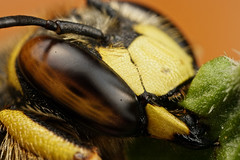One of the reasons why I haven't been shooting as much as I use to, other than I got burned out and needed a break, is that a lot of the areas I liked to shoot in are gone. I use to find the Wool Carder Bee, included with this post, at Lago de'Averno, sleeping in the Lavender that was planted along the jogging trail around the lake. Some of the people who visited the lake couldn't resist picking that flower, and what the locals didn't take a very voracious beetle ate the rest. Now that the city is paying someone to maintain the jogging trail there aren't any wildflowers around the lake either, so the only habitat for these magnificent creatures is on private land that I don't have access to.
Now that I'm living in a house with a yard I'm looking at the flowering plants and I'm trying to make sure that the critters have something to eat year round. Just this morning I spotted a male Wool Carder Bee tackle and mate with a female while she was feeding on the flowers in my basil. Hopefully it's the beginning of my own population of them :)
As for the photo itself: I spotted this bee sleeping in my basil in the evening, but waited until the next morning to photograph it. Large solitary bees like this one can get their metabolism going pretty easy, so had I tried to shoot it that evening it just would have flown away. Even though it was cooler in the morning it was still able to put up its front legs in a defensive posture, so I had to move slowly when approaching it with the camera.
I cut the flower that it was perched on with a pair of scissors, again being careful not to move it too fast. I then cleaned off the basil flowers in front of it, since they'd just be in the foreground and out of focus (too distracting). Then I simply held on to the basil flower with my left hand, rested the camera on that same hand so that everything was on the same "platform", and focused by sliding the lens on my hand (what I call the Left Hand Brace Technique). Being in full control of the motion in the scene leaves very little motion for the flash to freeze, and it's one of the reasons why I can get a lot of detail in a macro image even though I'm shooting at a relatively high Fstop. A lot of the image softening that most people blame on diffraction is really just motion blur...
Controlling the angle between the bee and the sensor on the camera is as easy as moving the flower between my thumb and index finger. What I look for is a "magic angle" that will make the most of what little depth I have in a single frame. Looking for new compositions and angles is easy since I'm not restricted by a focusing rail, and now that I've been shooting hand held for several years the muscle memory needed to move the subject and focus the scene is permanent (I can go months without holding a camera and still nail the focus and angle).
Last but not least: I'm not special, anyone can shoot the way I do -it just takes practice. Until next time happy shooting :)


No comments:
Post a Comment